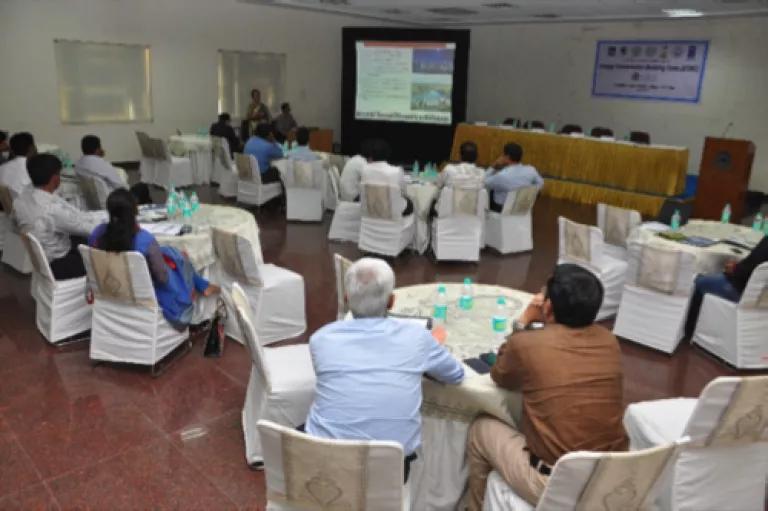Hyderabad Workshop Showcases How Real Estate Developers Benefit from an Energy-Saving Building Code

As temperatures soared this past month in India, energy demand to power air conditioners surged. Aware that the power grid is already strained by an energy deficit that includes the huge growth of energy-intensive buildings, officials in leading states are seeking ways to save energy. The states of Andhra Pradesh and Telangana have stepped up by mandating the incorporation of energy efficiency measures into new commercial buildings through an energy-saving buildings code called the Energy Conservation Building Code (ECBC). Last week, NRDC held a workshop with our partner, the Administrative Staff College of India (ASCI), in the states' shared capital city of Hyderabad to focus on addressing the challenges and opportunities for a critical sector of the buildings market: real estate developers. The workshop sought to address developers' biggest challenges with complying with the mandatory ECBC to ensure successful implementation of the code as new buildings are constructed and sold.
India is developing at a rapid pace. Recent reports have shown that the economy has grown by more than 7 percent in the last fiscal quarter. Such growth is leading to increasing per capita income and improving standards of living. Coupled with rapid urbanization, the rising demand for residential and commercial real estate places high energy demands on an already strained power grid. States across India, including Andhra Pradesh and Telangana, are taking serious action to improve energy management. Seeing that saving energy in the rapidly growing buildings sector is low hanging fruit, the two states have made the Energy Conservation Building Code (ECBC) mandatory for all new commercial buildings, including in the booming city of Hyderabad.

City of Hyderabad © Nehmat Kaur, NRDC
Ensuring construction and real estate properties meet ECBC requirements presents a significant opportunity for real estate developers. Energy prices are rising. Consumers and governments alike are looking to save energy and money.. With consumers demanding more efficient buildings, developers that comply with essential policies such as the ECBC can lead the market. In fact, moving ahead of the market and investing in efficiency now allows developers to charge a premium for offering energy-saving homes and offices to prospective buyers as well.
Since the ECBC's momentous adoption in the states of Andhra Pradesh and Telangana, more than 200 government officials have been trained in the new regulations through capacity building workshops across all districts in the two states. Of the three key types of players in the buildings energy efficiency market - government officials, building developers and the ultimate buyers - the real estate developers can serve as the lynchpin of effective compliance with the ECBC. With the government showing commitment through enactment of the ECBC and the consumers demanding energy efficiency, real estate developers can ensure greater overall success both through adopting energy efficient building practices and complying with the ECBC during construction.

Real Estate Developer Workshop in Hyderabad, June 2015 © Nehmat Kaur, NRDC
The NRDC and ASCI workshop held last week in Hyderabad focused on this important group: real estate developers. In addition to addressing developers' biggest challenges with ECBC compliance, the workshop also highlighted why these energy-saving measures are also cost-saving measures. Case studies jointly published by NRDC and ASCI were showcased, which effectively demonstrate how investing in energy-saving measures can offer attractive paybacks and significant savings during the life of a building.
The landmark case study of South Mumbai's Godrej Bhavan office building, for example, shows how energy efficiency investment can pay for itself and can mean more money in the bank. Just two years after the company Godrej & Boyce upgraded its iconic, six-story building, with a heavy retrofit of energy efficient lighting and HVAC system, electricity costs plummeted by 28 percent, while total electricity use dropped by 12 percent. The company stands to recover the costs of its substantial energy efficiency retrofits (INR 5,384,000/USD $99,704) in less than 5 years.
The case study Retrofitting Mahindra Towers: How an Innovative ESCO Model Lowers Energy Bills with No Upfront Cost highlights the strong business case for collaborating with an Energy Service Company (ESCO) to implement energy efficiency improvements. As the retrofit of Mahindra Towers, a Mumbai headquarters building, demonstrates, ESCOs are a key tool to advance India's efficient buildings market. With an overall investment of Rs. 18,90,000 ($39,375) for implementing energy conservation mechanisms (ECMs) that focused on improving efficiency in the building's lighting and cooling systems, Mahindra Towers had an impressive payback period of less than six months. Better yet, the ESCO model enabled Mahindra to make payments over time through the energy savings rather than make a high upfront payment for the energy efficiency improvements. The company now continues to profit from those energy and cost savings for the life of the building.
The case study of Noida's Legacy Spectral office building, a LEED Platinum certified, five-story building, shows the incredible energy and cost savings that can result from incorporating efficiency measures into new construction. The building owners recovered the additional investment on energy efficient construction within the first four years. In the first year of operation, electricity consumed was 50% lower than the estimated ASHRAE 90.1-2004 base case. Today, more than seven years after the construction was completed, the company (now acquired by AECOM) has recovered the additional cost of its energy-saving measures (INR 3,63,000/USD $88,000) and is saving at least INR 10,71,000 ($16,721) in annual energy bills.
Challenges identified by the developers at the Hyderabad workshop last week pertained mostly to the high incremental costs of constructing energy efficient buildings. They also articulated operational challenges that they are likely to face in ensuring compliance with ECBC. For instance, for a developer that doesn't provide central cooling and hands over the building to the owner prior to air conditioning equipment being installed, ensuring ECBC compliance over the lifecycle of the building becomes a challenge. Research and interaction with stakeholders has shown that monitoring is a crucial part of effective code compliance. Regular monitoring checks and guidelines issued to building occupants can build awareness on the benefits of efficiency. Further, engagement with developers, much like this workshop in Hyderabad, are crucial to understand and address these concerns together. Information and knowledge resources, such as those being developed by NRDC and ASCI based on suggestions from the Andhra Pradesh and Telangana governments, also support awareness on the benefits of saving energy and using efficient appliances.
Real estate developer have a real opportunity to become market leaders through code compliance with the ECBC. Saving energy and money is attractive to consumers and governments alike. Buyers are looking to save money by purchasing energy efficient homes and offices, making this an attractive growing market for real estate developers, who can fetch a higher value for these properties. With developers taking the lead, current power deficient cities can be transformed into energy secure cities and ultimately support India's progress and urbanization without compromising its strained resources.
